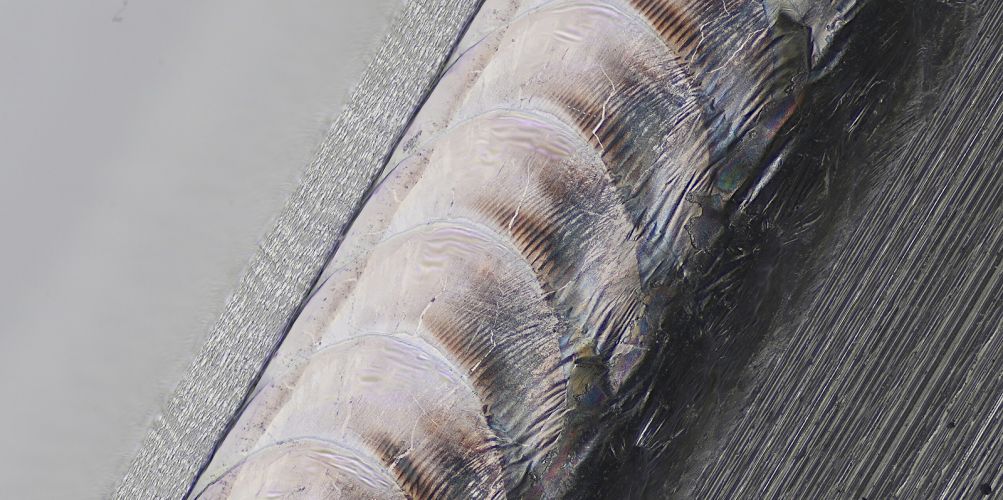What Is Laser Welding?
Laser welding is a process that uses a focused laser beam to join materials together — usually metals. Because the beam is so concentrated, it creates deep, narrow welds with minimal heat spread. That means less distortion, tighter tolerances, and better results in precision applications.
How Laser Welding Actually Works
Laser welding joins materials by focusing a high-energy laser beam onto the joint. The beam delivers intense heat into a very small area, causing the material to melt and fuse as it cools. Unlike traditional welding methods that use a consumable electrode or filler metal, laser welding is often performed autogenously — meaning it doesn’t require any filler at all.
There are two main operating modes depending on power density and application:
1. Conduction Mode Welding
In conduction welding, the laser heats the surface of the material, and the heat transfers downward through thermal conduction. This results in a wider, shallower weld, which is ideal when cosmetic appearance and minimal penetration are priorities — like in thin materials or delicate components.
2. Keyhole (Penetration) Mode Welding
At higher power densities, the laser beam doesn’t just melt the surface — it vaporizes it, forming a narrow cavity called a keyhole. This keyhole allows the laser to penetrate deeper into the material, producing deep, narrow welds with a high aspect ratio. The surrounding molten metal collapses behind the keyhole as the laser moves, forming a strong, continuous joint.
What Controls the Outcome?
A few key parameters control how the weld turns out:
-
Laser power — Higher power = deeper penetration
-
Focus position — Determines where the energy is concentrated
-
Travel speed — Affects heat input and weld shape
-
Material type — Some materials (like aluminum) reflect or conduct heat differently
-
Shielding gas — Used to prevent oxidation and help with beam coupling
Laser welding systems often use CO₂, fiber, or disk lasers depending on the power requirements and material compatibility. Automation is common, with beam delivery systems and motion stages enabling precise, repeatable welds in production environments.
Why Laser Welding Can Be a Great Choice
-
It’s extremely precise
You can control the depth and width of the weld very accurately, which is great for detailed parts or delicate assemblies. -
Minimal heat = minimal distortion
Since the heat is so localized, surrounding materials don’t warp like they might with traditional welding. -
It’s fast
Laser welding can be much quicker than MIG or TIG, especially when automated. -
Works with all kinds of materials
Including dissimilar metals, thin sheets, and more — as long as the setup is dialed in. -
Perfect for automation
Lasers are easy to integrate into robotic systems for repeatable, high-speed production.
But There Are Tradeoffs
-
It’s not cheap
Laser welding equipment costs more than conventional welding machines — sometimes a lot more. -
It’s picky about fit-up
You’ll need tight tolerances between parts. Gaps or misalignment can lead to poor results or no weld at all. -
Not ideal for thick materials
Very thick sections might need multiple passes or just aren’t a good fit for this process. -
Reflective metals are tricky
Materials like aluminum or copper can reflect the beam unless you manage it properly. -
Safety is a factor
You’re working with a high-powered laser. That means protective housing, interlocks, and safety glasses — no exceptions.
Where Laser Welding Really Shines
-
Automotive — fast, strong welds in transmission parts and body components
-
Medical — super clean welds for surgical tools and implants
-
Electronics — precision without damaging heat-sensitive parts
-
Aerospace — lightweight welds in high-performance materials
Final Thoughts
Laser welding isn’t a one-size-fits-all solution. But in the right application — especially where precision, cleanliness, and automation matter — it can be a game-changer. Just keep in mind the upfront cost and make sure it matches the kind of work you're doing.

Industrial Laser Components
Haas Laser Technologies designs high-performance beam delivery components for cutting, welding, and drilling applications. We also offer custom solutions and expert consulting to help you with every step of your laser processing project or product.
- Beam Delivery Components
- Laser Optics
- Beam Diagnostic Tools
- Custom Laser Systems
